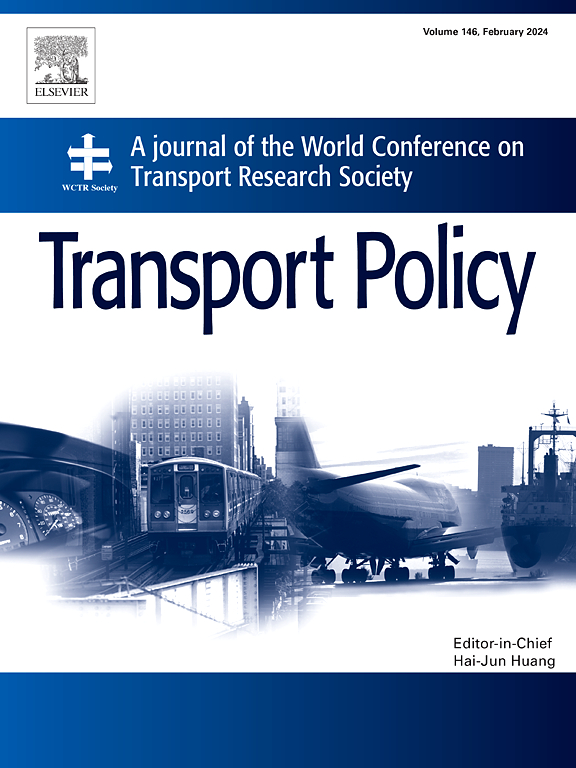Understanding preferences for autonomous trucks functions in China: Insights from drivers and organizational buyers
IF 6.3
2区 工程技术
Q1 ECONOMICS
引用次数: 0
Abstract
The transportation industry is undergoing a significant transformation as it integrates advanced driver assistance systems (ADAS) technologies. This shift is particularly important in the trucking industry. Driver assistance technologies offer a promising solution for improving safety and reducing traffic accidents. However, the trucking industry lags significantly behind passenger vehicles in the maturity and penetration rate of such technologies. This study uses a stated preference survey to explore the purchasing preferences for ADAS functions among truck drivers and organization buyers in China. Our findings show that truck drivers with a safe driving history prioritize reliability and assistance features such as automatic emergency braking, adaptive cruise control, and lane-centering control. In contrast, drivers with a record of unsafe driving favor more advanced ADAS functions, such as city or highway navigation on autopilot, owing to their ability to alleviate driving stress. Buyers from organizations, compared with individual truck drivers, are more averse to the additional costs of ADAS technologies, while larger companies seem more willing to invest in autonomous trucks than are smaller businesses and individuals. However, top management teams remain cautious, reflecting a lack of confidence in the operational and safety benefits of the current technology at Level 2 autonomy. Resistance to adopting autonomous trucks is also stronger among male (vs. female) drivers and older drivers, who comprise a large segment of the domestic market. The study recommends that autonomous vehicle system providers and governments prioritize active safety functions to further improve safety. Furthermore, it is suggested that extensive training and trials be provided to increase trust and confidence in autonomous truck technologies among industry stakeholders.
了解中国对自动驾驶卡车功能的偏好:来自司机和组织买家的见解
随着先进驾驶辅助系统(ADAS)技术的整合,交通运输行业正在经历一场重大变革。这种转变在卡车运输行业尤为重要。驾驶辅助技术为提高安全性和减少交通事故提供了一个很有前途的解决方案。然而,卡车行业在此类技术的成熟度和渗透率方面明显落后于乘用车。本研究采用陈述偏好调查的方法,探讨中国卡车司机和组织购买者对ADAS功能的购买偏好。我们的研究结果表明,具有安全驾驶历史的卡车司机优先考虑可靠性和辅助功能,如自动紧急制动、自适应巡航控制和车道中心控制。相比之下,有不安全驾驶记录的司机更喜欢更先进的ADAS功能,比如自动驾驶的城市或高速公路导航,因为它们能够减轻驾驶压力。与个人卡车司机相比,来自企业的买家更不愿意为ADAS技术带来额外成本,而大公司似乎比小企业和个人更愿意投资自动驾驶卡车。然而,高层管理团队仍持谨慎态度,反映出对当前技术在2级自动驾驶下的操作和安全优势缺乏信心。在国内市场中占很大比重的男性司机和老年司机对自动驾驶卡车的抵制也更强烈。该研究建议自动驾驶汽车系统供应商和政府优先考虑主动安全功能,以进一步提高安全性。此外,建议提供广泛的培训和试验,以增加行业利益相关者对自动驾驶卡车技术的信任和信心。
本文章由计算机程序翻译,如有差异,请以英文原文为准。
求助全文
约1分钟内获得全文
求助全文
来源期刊

Transport Policy
Multiple-
CiteScore
12.10
自引率
10.30%
发文量
282
期刊介绍:
Transport Policy is an international journal aimed at bridging the gap between theory and practice in transport. Its subject areas reflect the concerns of policymakers in government, industry, voluntary organisations and the public at large, providing independent, original and rigorous analysis to understand how policy decisions have been taken, monitor their effects, and suggest how they may be improved. The journal treats the transport sector comprehensively, and in the context of other sectors including energy, housing, industry and planning. All modes are covered: land, sea and air; road and rail; public and private; motorised and non-motorised; passenger and freight.
 求助内容:
求助内容: 应助结果提醒方式:
应助结果提醒方式:


